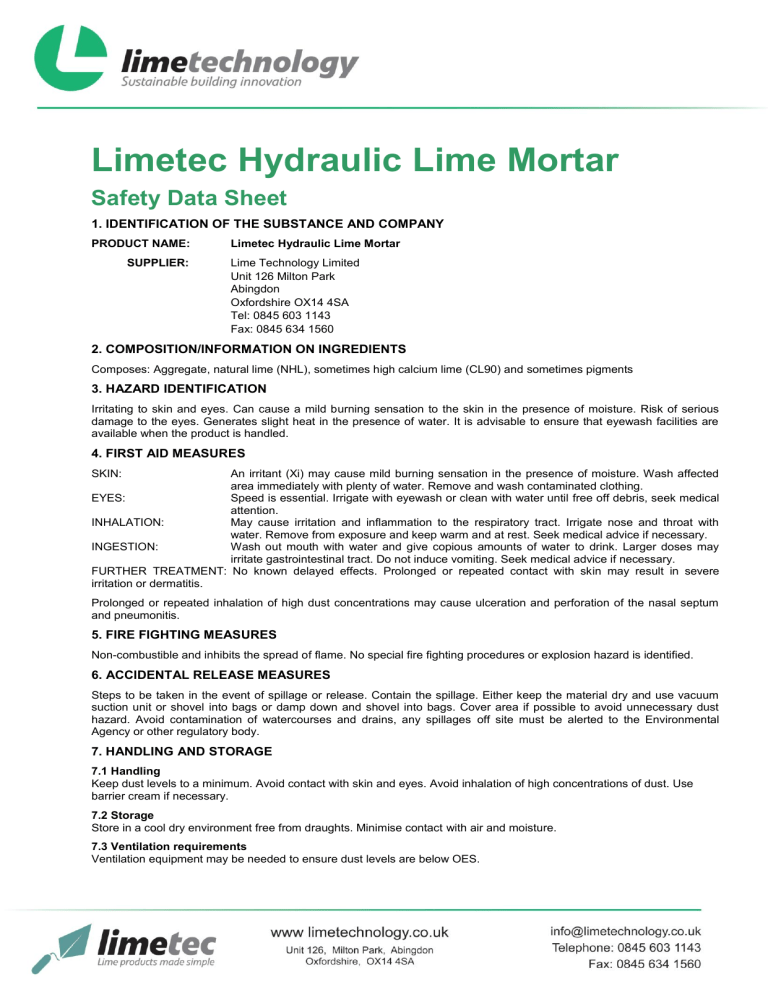Limetec Hydraulic Lime Mortar

Limetec Hydraulic Lime Mortar
Safety Data Sheet
1. IDENTIFICATION OF THE SUBSTANCE AND COMPANY
PRODUCT NAME:
SUPPLIER:
Limetec Hydraulic Lime Mortar
Lime Technology Limited
Unit 126 Milton Park
Abingdon
Oxfordshire OX14 4SA
Tel: 0845 603 1143
Fax: 0845 634 1560
2. COMPOSITION/INFORMATION ON INGREDIENTS
Composes: Aggregate, natural lime (NHL), sometimes high calcium lime (CL90) and sometimes pigments
3. HAZARD IDENTIFICATION
Irritating to skin and eyes. Can cause a mild burning sensation to the skin in the presence of moisture. Risk of serious damage to the eyes. Generates slight heat in the presence of water. It is advisable to ensure that eyewash facilities are available when the product is handled.
4. FIRST AID MEASURES
SKIN:
EYES:
INHALATION:
An irritant (Xi) may cause mild burning sensation in the presence of moisture. Wash affected area immediately with plenty of water. Remove and wash contaminated clothing.
Speed is essential. Irrigate with eyewash or clean with water until free off debris, seek medical attention.
May cause irritation and inflammation to the respiratory tract. Irrigate nose and throat with
INGESTION: irritate gastrointestinal tract. Do not induce vomiting. Seek medical advice if necessary.
FURTHER TREATMENT: No known delayed effects. Prolonged or repeated contact with skin may result in severe irritation or dermatitis. water. Remove from exposure and keep warm and at rest. Seek medical advice if necessary.
Wash out mouth with water and give copious amounts of water to drink. Larger doses may
Prolonged or repeated inhalation of high dust concentrations may cause ulceration and perforation of the nasal septum and pneumonitis.
5. FIRE FIGHTING MEASURES
Non-combustible and inhibits the spread of flame. No special fire fighting procedures or explosion hazard is identified.
6. ACCIDENTAL RELEASE MEASURES
Steps to be taken in the event of spillage or release. Contain the spillage. Either keep the material dry and use vacuum suction unit or shovel into bags or damp down and shovel into bags. Cover area if possible to avoid unnecessary dust hazard. Avoid contamination of watercourses and drains, any spillages off site must be alerted to the Environmental
Agency or other regulatory body.
7. HANDLING AND STORAGE
7.1 Handling
Keep dust levels to a minimum. Avoid contact with skin and eyes. Avoid inhalation of high concentrations of dust. Use barrier cream if necessary.
7.2 Storage
Store in a cool dry environment free from draughts. Minimise contact with air and moisture.
7.3 Ventilation requirements
Ventilation equipment may be needed to ensure dust levels are below OES.
8. EXPOSURE CONTROL AND PERSONAL PROTECTION
8.1 Handling systems should preferably be enclosed or suitable ventilation installed to maintain atmospheric dust below
OEL (occupational exposure limit). All ventilation systems should be filtered before discharge.
8.2 If the atmospheric dust exceeds OEL wear suitable personal protective equipment. Use approved dust respirators to
EN 149 category FFP2 or air stream helmet for heavy exposure.
8.3 Wear suitable gloves, overalls and eye/face protection. Rubber, leather or fabric/composite gloves provide suitable hand protection. Long sleeved overalls are recommended, close fitting at openings. Wide vision full goggles with anti-mist for eye protection. Wear boots that resist dust penetration.
9. PHYSICAL AND CHEMICAL PROPERTIES
Form
–
Colour
–
Solid of varying sizes. Lump, granular or fine powder.
Creamy, grey or coloured in dry form.
Odour – pH
–
Faint earthy odour.
1.5 - 13 (as aqueous solution approx. 2g/litre).
Solubility in water (NHL content only)
– 1760mg/litre saturated solution at 100ºC (reacts with water for calcium hydroxide).
10. STABILITY AND REACTIVITY
10.1 Stable.
10.2 Hazardous decomposition products – none.
11. TOXICOLOGICAL INFORMATION
High concentrations of dust are an irritant to the respiratory tract. Gross inhalation may cause inflammation, ulceration, perforation of the nasal septum and pneumonitis. Prolonged repeated inhalation of high dust concentration may cause similar effects.
Irritant to the skin in the presence of moisture. May cause burns. Prolonged and repeated contact with skin may result in severe irritation or dermatitis.
Very painful irritant to the eyes
– may cause burns. Risk of severe and permanent damage to eyes.
If swallowed, may cause corrosion damage to the gastrointestinal tract
The product is considered to be non-toxic.
12. ECOLOGICAL INFORMATION
Strongly soluble in water to form alkaline solution. Low mobility in moist ground conditions. Non bio-degradable, reacts with moisture to form calcium hydroxide, reacts with atmospheric and dissolved carbon dioxide to for calcium carbonate.
The product is considered to be non-toxic.
13. DISPOSAL CONSIDERATIONS
Disposal should be in accordance with local and national legislation.
14. TRANSPORATION INFORMATION
Not classified as hazardous for transportation.
15. REGULATORY INFORMATION
The Chemicals (Hazard Information and Packaging for Supply) Regulations 2002.
Classification for supply: Irritant Classification for Conveyance: None
Risk phases R36/38
– Irritating to eyes and skin R41 – Risk of serious damage to eyes R43
Contact with skin may cause mild burning sensation
Safety phases S2
– Keep out of reach of children S22 – Do not breathe dust S24/25 Avoid contact with skin and eyes S26
In case of contact with eyes, rinse immediately with plenty of water and seek medical advice S37 – Wear suitable gloves
S39
– Wear eye/face protection
Low Chromate content according to TRGS 613.
16 OTHER INFORMATION
HSE Guidance Notes EH40: Occupational Exposure Limits (current edition) EH42: Monitoring Strategies for Toxic
Substances EH44: Dust in the Workplace: General principles of Protection.



